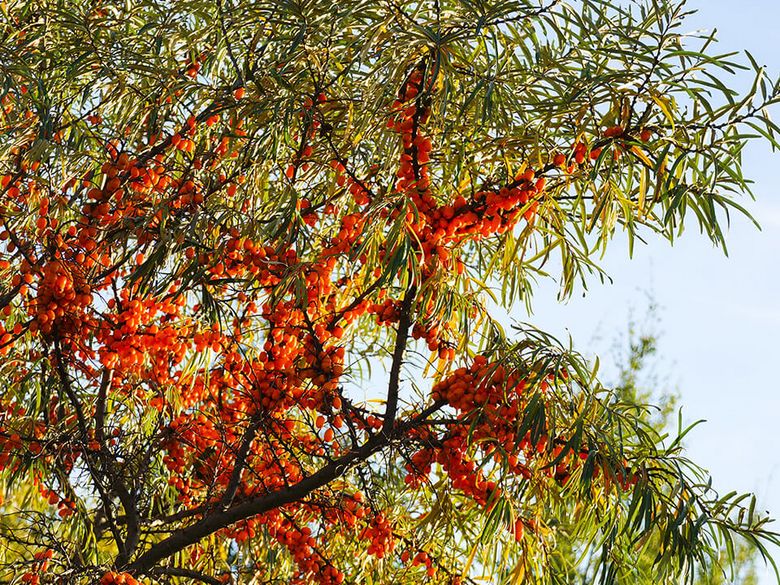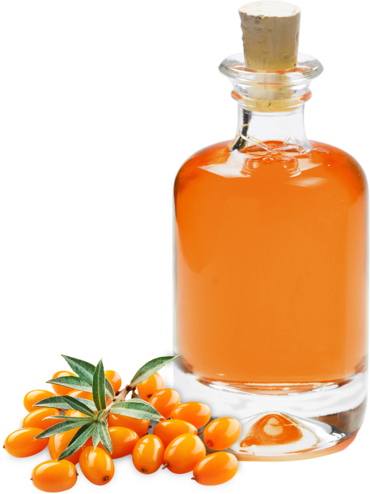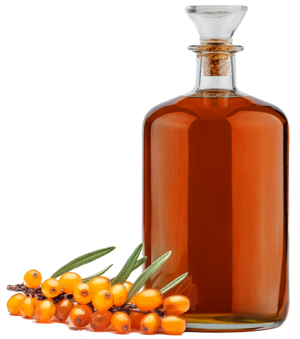Our Sea buckthorn oil qualities
We carry Sea buckthorn oil in the following qualities for you
Usage
|
Cosmetics |
Food |
Pharmaceutics |
|
|---|---|---|---|
| Sea buckthorn oil virgin | |||
| Organic sea buckthorn oil virgin |

Sea buckthorn bush & sea buckthorn berry
Sea buckthorn (Hippophae rhamnoides) is a wild fruit that grows on a shrub. It is often referred to as the lemon of the north, but also as pheasant berry or dune thorn. Sea buckthorn is a plant species from the genus of sea buckthorn (Hippophaë) within the oleaginous family (Elaeagnaceae).
Sea buckthorn (Hippophae rhamnoides) is a hardy, spiny shrub. It reaches a height of 1 to 6 meters and a width of up to 4 metres. The branches of the sea buckthorn shrub form thorny short shoots and, similar to the buds, appear bronze to silver-grey due to numerous small adjacent scales. The extensive dense root system of the sea buckthorn reaches a depth of 1.5 to 3 meters and can spread horizontally within a radius of up to 12 meters. As a pioneer plant, this gives the sea buckthorn a firm foothold on dunes or artificially created hillsides and binds the soil. This is why sea buckthorn is also planted for the recultivation of wasteland. The leaves reach a length between 40 and 80 millimeters and a width between 3 and 8 millimeters.
The small yellowish, inconspicuous, unisex flowers of the sea buckthorn are visible in Europe between March and May. The bright yellow to orange sea buckthorn berries ripen between August and December. These are characteristically 6 to 8 millimeters long, oval and botanically known as pseudo stone fruits. The berries are known for their high vitamin C content and are therefore processed into food and beverages as well as skin care products.
Inside the berries are the stone-like, elongated to round, outside brown-coloured seeds with a white kernel. They are 2.8 to 5.3 millimeters long and their width ranges from 1.4 to 2.7 millimeters.
As a winter resident, the fruits are an important resource for birds in the cold season.
Sea buckthorn is a pioneer plant and prefers calcareous sand and gravel soils in sunny locations. The shrub is often found in pine forests, along dried out rivers and on rocky slopes and gravelly shores. As a pioneer plant, it is a common species along sea coasts, especially on fixed dunes, but also in steppes. As secondary habitats, sea buckthorn inhabits gravel pits and road embankments.
Would you like to be informed about the general market situation of Sea buckthorn oil and our other products?
subscribe to market reportCultivation & yield
The production of sea buckthorn oil is similar to the production of olive oil. The fruits are harvested either by hand or with a scraper rake. This is relatively difficult because of the many thorns. An alternative is the so-called milking: In this process the juice is pressed directly from the berries on the branch. These two methods are harmful to the plant, the yield is low and the risk of injury is high. The best method is to cut selected branches from the shrub with a particularly large number of berries. They are then shock-frozen at -35 to -40°C and after 3-4 days the berries are removed from the branch by a shaking machine. Contaminants are removed and the fruits are washed. Due to these difficult harvesting conditions and the long start-up phase of about four to six years until the first harvest, sea buckthorn is a relatively expensive raw material.
The sea buckthorn bush is now also native to Germany and has been cultivated here since the end of the 1960s. The main German cultivation areas are in Brandenburg, Mecklenburg-Vorpommern and Sachsen-Anhalt. The main distribution area of the sea buckthorn bush is in East and West Asia and includes both Siberia and China. The European distribution area stretches over Central Europe from the Pyrenees to the Alps and the Alpine foothills to the Caucasus. It also covers northwestern Europe and finds its northern border in Norway.

Background / history
The sea buckthorn bush originally comes from the Himalayas.
Already for 1200 years these oils have been used medically in Tibet, both internally and externally.
In traditional medicine, sea buckthorn has been used for centuries for its health-promoting properties.
190
kg
Drum
30
kg
Canister
10
kg
Canister
General durability: canister 12 months, drum 18 months
Nutritional values & composition
| Nutritional value | (per 100g) |
| Energy | 3,700 kJ / 900 kcal |
| Fat | 100 g |
| Saturated fatty acids | 35 g |
| Monounsaturated fatty acids | 60 g |
| Polyunsaturated fatty acids | 5 g |
Fatty acids ratio
Composition
| C16:0 Palmitic acid | 25 – 45 % |
| C16:1 Palmitoleic acid | min. 20 % |
| C18:1 Oleic acid | 15 – 35 % |
You want to buy Sea buckthorn oil?
Request now free of charge and without obligation from Gustav Heess. We deliver Sea buckthorn oil ...
- worldwide
- fast
- reliable
We offer Sea buckthorn oil in the following packaging units:
-
190
kg
Drum -
30
kg
Canister -
10
kg
Canister
